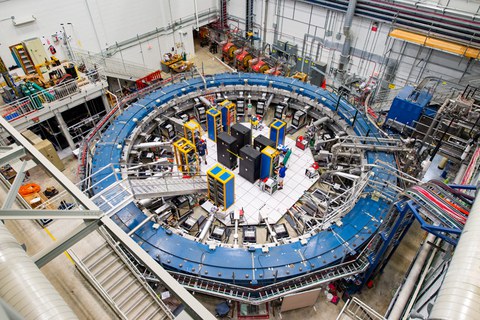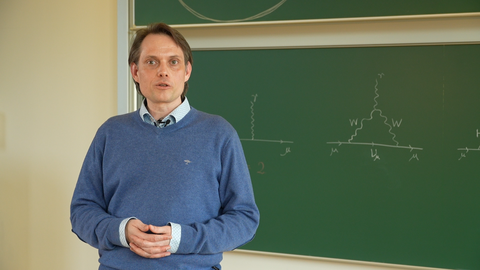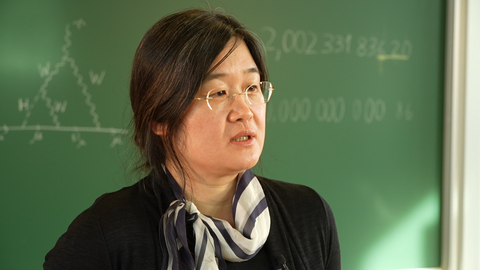06.04.2021
Myon g-2: Kleines Teilchen mit großer Wirkung

Der Muon g-2 Ring befindet sich in seiner Detektorhalle inmitten von Elektronikregalen, der Myonen-Beamline und anderen Geräten. Dieses beeindruckende Experiment arbeitet bei minus 450 Grad Fahrenheit und untersucht die Präzession (oder das Wobbeln) von Myonen, während sie durch das Magnetfeld reisen.
Prof. Dominik Stöckinger vom Institut für Kern- und Teilchenphysik der TU Dresden ist an dem großangelegten Myon g-2-Experiment des Fermilab in den USA beteiligt. Nun steht die Kollaboration vor einem Sensationsmoment, der die Geschichte der Teilchenphysik neu schreiben könnte und vielleicht sogar Hinweise auf noch unbekannte Teilchen im Universum gibt. Seit vielen Jahren widmen sich er und seine Frau Dr. Hyejung Stöckinger-Kim, ebenfalls Wissenschaftlerin am Institut Kern- und Teilchenphysik, diesem Thema auch von theoretischer Seite.
Das Standardmodell der Elementarteilchenphysik beschreibt die wesentlichen Erkenntnisse über alle bekannten Elementarteilchen und ihre Wechselwirkungen. Dennoch gibt es einige Gründe zur Annahme, dass eine Physik jenseits des Standardmodells existiert. Zahlreiche offene Fragen, wie zum Beispiel die Existenz Dunkler Materie oder die Masse von Neutrinos vermag das Standardmodell allein nicht zu lösen.
In großangelegten Experimenten suchen internationale Kollaborationen von Wissenschaftlerinnen und Wissenschaftlern nach Antworten, in dem sie die theoretischen Vorhersagen experimentell nachweisen. Am Fermi National Accelerator Laboratory, kurz Fermilab, im Bundesstaat Illinois der USA steht eines dieser Großexperimente vor einem bedeutenden Durchbruch. Anhand von Messungen des anomalen magnetischen Moments des Myons, der sogenannten Größe „g-2“, können die Wissenschaftlerinnen und Wissenschaftler alle bekannten Wechselwirkungen und Elementarteilchen nachweisen, von Elektronen über Photonen bis hin zum Higgsboson. Myonen ähneln in vielen ihrer Eigenschaften den Elektronen, sie sind nur viel schwerer und sind Hauptbestandteil der sekundären kosmischen Strahlung. Alle Wechselwirkungen und Elementarteilchen tragen mit ihren jeweiligen Eigenschaften zu der Größe „g-2“ des Myons bei und gleichzeitig ist es eine der präzisesten berechneten und gemessenen Größen der Elementarteilchenphysik. Bei einer im Jahr 2001 durchgeführten Messung ergab sich jedoch eine signifikante Abweichung der experimentell ermittelten Größe vom Standardmodell. Sind dafür bisher unbekannte Teilchen verantwortlich? Vielleicht. Leider war das Experiment nicht empfindlich genug, um eine zufällige Fluktuation des Messwerts als Ursache auszuschließen.

Prof. Dr. Dominik Stöckinger
Am Fermilab wurden 2018 neue, äußerst präzise Messungen zur erneuten Überprüfung des „g-2“-Wertes des Myons durchgeführt. Prof. Dominik Stöckinger vom Institut für Kern- und Teilchenphysik der TU Dresden war von Stunde null an dem Mammut-Projekt beteiligt: „Das Myon g-2 Experiment am Fermilab hat das Potential, als erstes Experiment die Existenz von Physik jenseits des Standardmodells unter menschengemachten, kontrollierten Laborbedingungen direkt zu beweisen. Die Auswertung der Daten ist extrem anspruchsvoll, da eine Genauigkeit von besser als eins zu einer Million angestrebt wird, und das sogenannte „Unblinding“, also die Aufschlüsselung der Daten, ist ein großer Moment für die Physikwelt. Wenn das Experiment einen anderen Wert als den des Standardmodells ergibt, bedeutet das, dass unser derzeitiges Verständnis der Physik unvollständig ist, und es könnte auf die Anwesenheit zusätzlicher Teilchen oder verborgener subatomarer Kräfte hinweisen. Es würde die Tür zu aufregenden neuen Bereichen der Wissenschaft öffnen.“

Dr. Hyejung Stöckinger-Kim
Gemeinsam mit seiner Frau Dr. Hyejung Stöckinger-Kim arbeitet der theoretische Physiker an der Überprüfung des Standardmodells durch noch präzisere Berechnungen und dem Aufstellen von Alternativtheorien: „Was wäre wenn und wie stark würde sich „g-2“ dann ändern?“ – gehört zu den Leitfragen ihrer Arbeit. Es ist also relativ egal, welchen Wert das Experiment ergibt, die Stöckingers haben in jedem Fall aufgrund ihrer umfangreichen Vorarbeiten schon eine theoretische Erklärung dazu, die sie im Anschluss auch veröffentlichen werden.
Die Präsentation der Ergebnisse des Fermilabs findet im Rahmen einer Online-Pressekonferenz am 7. April 2021, 19 Uhr MEZ statt.
Link zur Pressekonferenz: https://fnal.zoom.us/j/95785531415?pwd=V1N4bjlNMEJTRlVvYzZMU2NJRzVXdz09
Webseite des Myon g-2-Experiments am Fermilab: https://muon-g-2.fnal.gov/
Das Fermilab in den USA veröffentlicht am 7. April die Ergebnisse eines physikalischen Experiments zum Myon. Daran waren zahlreiche Wissenschaftlerinnen und Wissenschaftler weltweit beteiligt – auch von der TU Dresden. © Benjamin Griebe/ TUD
Kontakt für Journalisten:
Prof. Dominik Stöckinger
Institut für Kern- und Teilchenphysik
Email: